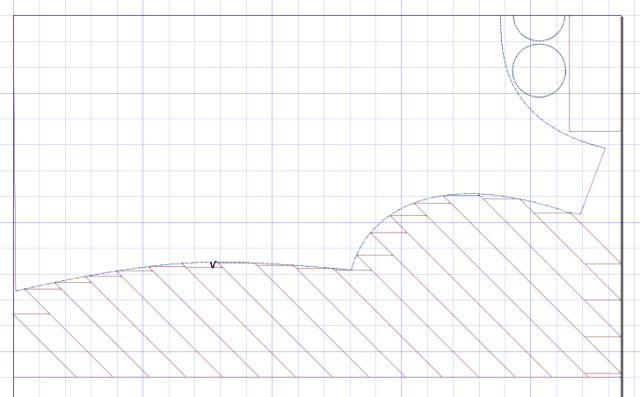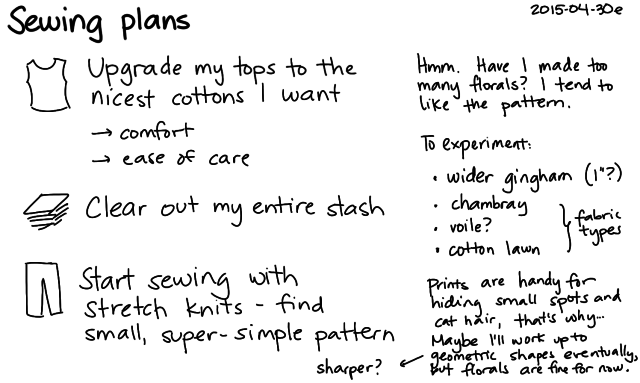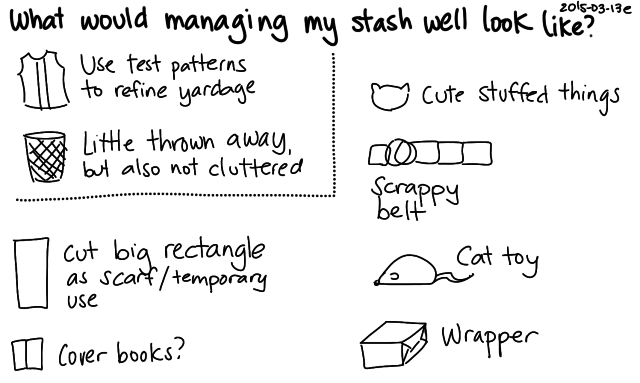Some people love shopping. That’s why “retail therapy” is a thing. Other people hate shopping, and try to do it as little as possible. It’s hard to find anything I like, even after I talk myself into being okay with buying things at full retail price, and even after adjusting my price range higher and higher.
I tried desensitizing myself by going out shopping without a particular goal in mind, just familiarizing myself with the colours and styles, and being open to buying something if it appealed to me. Several weekends of this turned up a few pairs of pants and T-shirts, but no epiphanies.
I started looking into alternatives. It seems wardrobe stylists work on commission, so you should plan to spend a good chunk of money – maybe $500 or $1000, which was more than I wanted to do at that moment. The custom dressmakers I asked quoted me rates around $250 for a single garment (although I didn’t ask if they’d reduce it for a super-simple pattern). Online tailors had very mixed reviews.
I figured it would be worth giving sewing a try. I didn’t need anything fancy, after all. I spent a few hours looking around for the simplest free pattern for a top, and I settled on the Colette Sorbetto pattern. I sewed a few, and then simplified the pattern further by removing the pleat. I sewed a few more. When I learned how to use the laser cutter, I used the laser to quickly and accurately cut even more pieces for sewing.
Let’s talk numbers.
The typical shirts I like cost between $40 and $120 at the store, but take hours and hours to shop for. It’s also a tiring and frustrating experience.
Broadcloth costs $2 a yard. Quilting fabric and cotton shirting tend to be around $12 to $14 a yard. The fanciest cotton I can get (in terms of fabric, not just design) seems to be Liberty cotton lawn, at $24 a yard. I wasn’t sure if it would be worth it, but it is nicely breathable, so maybe. I typically buy 1.5 yards per top, although this leaves me with lots of excess fabric. I could probably fit a top in 1 yard.
I’ve spent about $130 for the 16 tops I’ve made so far, or an average of $8 per top. I expect future tops to cost between $15 to $40, depending on fabric quality and whether the design is one-way.
The bulk of the cost is really time. Since I started in February, I’ve spent 105 hours sewing: picking out fabric, cutting, sewing, thinking about patterns and plans. This is an average of 7 hours per top, which feels a bit on the high side. I think most of it is indecisiveness about fabric. =) Prepping and cutting the fabric on the laser takes maybe 20 minutes total, and once that’s done, I can sew a top in about 2 hours.
You can analyze time trade-offs by assigning an arbitrary value to them. You might use minimum wage, or the replacement cost of hiring someone to take on some of your lower-value activities for you. For example, you might use $15/hour as a replacement cost, since that seems to be the going rate for a housekeeper in Toronto. If so, then my tops have cost an average of $110 or so. I expect future tops to use nicer fabric but require less time, so the estimated cost will likely be $75-100 per top.
Alternatively, you could use a higher rate – say, my consulting rate – since I could theoretically be working instead of sewing. But I don’t particularly feel like working more. If I did, there would be other activities I would cut back on first, like playing video games, or reading fiction.
Where did the time come from? It’s hard to say, since I was changing some of my other routines too. Anyway, I analyzed a weekly summary of my time records, correlating different categories with the time I tracked under sewing.
| Category |
Correlational coefficient |
| Business – Build – Learn |
-0.94 |
| Business – Build – Quantified Awesome |
-0.92 |
| Discretionary – Productive – Japanese |
-0.82 |
| Business – Build – Drawing |
-0.64 |
| Discretionary – Play – Read – Fiction |
-0.61 |
I shifted away from learning, coding, and Japanese review, and I reduced my drawing and reading time. They’re all discretionary activities, so it’s not like I was working less or sleeping less in order to sew. (I actually worked a little more than I did before.)
I’ve come to think of sewing as fun, so I might consider the time as “free.” In fact, it might even have a positive effect. Making things myself helps me develop skills and enables imagination, so it’s like education. Cost-wise, it feels like spending on fabric and time is a definite win compared to, say, buying fast fashion tops that may or may not be ethically sourced.
What did I learn?
I learned that it takes surprisingly little time and money to develop a comfortable level of skill when repeating the same sewing pattern. I started sewing on Feb 11. On Feb 23, after about six hours total, I wore my first top. Here you can see DIY taking over the clothes I wear:
| Week starting |
Sat |
Sun |
Mon |
Tue |
Wed |
Thu |
Fri |
| Feb 7 |
x |
x |
x |
x |
x |
x |
x |
| Feb 14 |
x |
x |
x |
x |
x |
x |
x |
| Feb 21 |
x |
x |
mine |
x |
x |
mine |
x |
| Feb 28 |
x |
x |
x |
mine |
x |
x |
x |
| Mar 7 |
x |
x |
x |
mine |
mine |
mine |
mine |
| Mar 14 |
mine |
x |
mine |
mine |
mine |
mine |
mine |
| Mar 21 |
mine |
mine |
mine |
mine |
mine |
mine |
mine |
| Mar 28 |
x |
mine |
mine |
mine |
x |
mine |
mine |
| Apr 4 |
x |
x |
mine |
mine |
x |
mine |
mine |
| Apr 11 |
x |
mine |
mine |
mine |
mine |
mine |
mine |
| Apr 18 |
mine |
mine |
mine |
mine |
mine |
mine |
mine |
| Apr 25 |
mine |
mine |
mine |
mine |
mine |
mine |
mine |
| May 2 |
x |
x |
mine |
mine |
mine |
mine |
mine |
I learned that I really enjoy the things you can’t buy with money. There’s this feeling of freedom that comes with knowing that I don’t have to rely on manufacturers and retailers to make things I like. I might even be able to come up with things that I wouldn’t be able to find in stores. If things wear out, I can repair or replace them.
I have two more tops on the go, so that should bring me to a total of eleven cotton/polyester tops and seven 100% cotton ones. I think I’ll hold off on sewing more tops after that. Maybe I’ll sew containers and bags to use up my scraps, and then I’ll think about sewing other things I wear. I’m not interested in sewing things for anyone else (aside from family, maybe), so don’t bother asking me. <laugh>
Anyway, it was a pleasant surprise to find out that it was easy to reduce the high-stress, low-value activity of shopping with something I enjoy much more. =)







































